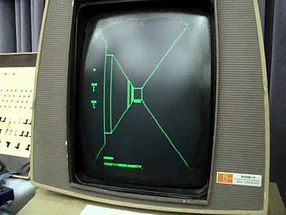Maze War
| Maze War | |
|---|---|
| Maze was on an Imlac PDS-1 | |
| Studio | Steve Colley |
| Publisher | MacroMind (Macintosh, 1986) |
| Erstveröffent- lichung |
from 1974 (network version) |
| platform | Mainframe , Xerox Alto etc. a. |
| genre | Maze , first-person shooter |
| Game mode | Multiplayer (2-32) |
| control | keyboard |
| system advantages preconditions |
Modem / network |
| information | Is considered the first-person shooter. |
Maze War (English for Labyrinth War), also Maze Wars, Mazewar, The Maze Game or Maze is one of the first first-person shooters and was published in 1974. Developed the game about 1,973 of the student Steve Colley was originally on a Imlac PDS-1 minicomputer at the Ames Research Center of NASA in California. The author cannot remember the exact year of development; the network version, however, dates from 1974. It was later also released for the Xerox Alto (around 1977), as well as for NeXT and PalmOS systems. The game was marketed commercially under the name of MazeWars + by the US company MacroMind in 1986 for the Apple Macintosh . It is also one of the first network games and one of the first with a level editor and in-game chat . Either two players can play via a modem or up to 30 players in real time via the AppleTalk network protocol or up to 32 players depending on the system. However, a significantly smaller number of players is recommended. The original Imlac source code, which was also encrypted, is no longer preserved.
description
In the upper half of the Alto screen, which exists in portrait format, is the 3D maze, which is created by lines. Below is a block graphic that shows the labyrinth from a bird's eye view.
The players move step by step through the maze using the keyboard. There are four buttons for each direction and the space bar for shooting. An opponent, if you meet him, is shown in the 3D view as a flying ball that resembles an eyeball. You can see the direction of the opponent by looking at the eye. So it is possible to be suddenly hit from behind. This is then indicated by a flashing inversion of the screen graphic. A player has four lives and is promoted to a random position after each hit.
In addition to the player opponents, there are computer-controlled robot opponents who also shoot, as well as ducks that only move.
Ego perspective or bird's eye view is displayed on the Imlac computer; Hits are similar to glass bullet holes. In contrast to the black and white raster graphics of the Altos, the Imlac is vector graphics on a monochrome monitor (usually green lines).
Ports and similar games
| year | Name of the game | platform | Graphics / size of the maze | network | developer | particularities |
| 1973 | Maze War | Imlac PDS-1 | green vectors, Maze 16 × 16 | 2 computers connected in series | Steve Colley | Original version |
| 1974 | Maze War | Imlac | green vectors, Maze 16 × 32 | 8 player PDP-10 server / ARPANet | Greg Thompson | Network version |
| 1977 | MazeWars | Xerox Star / Alto | Black and white raster graphics | 32 player ethernet | Jim Guyton | |
| 1982 | Snipes | DOS | ASCII graphics white on black or color | CP / M network, LAN | Drew Major, Kyle Powell | Deathmatch mode, not 3D |
| 1986 | MazeWars + | macintosh | Raster graphics | AppleTalk 30 players | MacroMind | |
| 1992 | Great MazeWars | macintosh | 256 color raster graphics | AppleTalk 30 players | Callisto |
A comparable game, also for multiple players and flying eyes, is MIDI Maze for the Atari ST.
There are many other games with similar 3D mazes, mostly Pac-Man variants such as 3-Demon , or 3D Monster Maze . However, these games are not shooters and can usually only be played alone.
In 1992 a DOS version of Maze War was released. There are also other clones for other computers, including a. for Windows.
In March 1974, Spasim appeared , which is also traded as the first first-person shooter. This is a space shooter.

